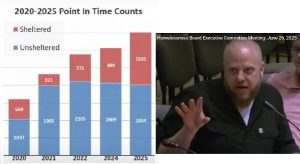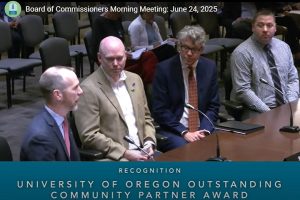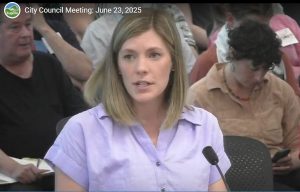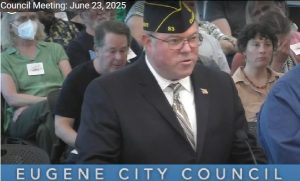City, county could adopt River Road-Santa Clara plan in April, discarding years of volunteer effort
15 min read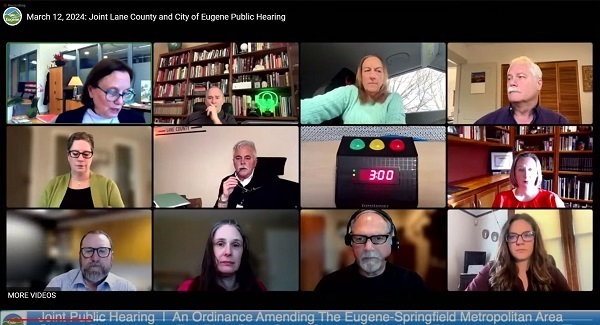
River Road and Santa Clara neighbors predict future parking problems, and lament that ‘our dreams have been downsized.’ At least the city addressed concerns from River Avenue business owners. In response to public comments from Action Rent-All and Clemens Marina, the city changed its proposal. At the city / county joint public hearing March 12:
Terri Harding (Eugene principal planner): I do want to take care to clarify that the proposed prohibition of certain uses will apply to the C-2 zoned areas within River Road and Santa Clara, except for River Avenue. So there’s some detail about that and we’ll further elaborate in the memo. But those businesses, specifically Clemens (Marina) and Action Rent-All located along River Avenue are, in the proposal before you, carved out of that. So they will not become nonconforming uses if this is approved.
[00:01:06] Louie Vidmar (Santa Clara): My name is Louie Vidmar and I live in the Santa Clara neighborhood. I’ve lived here since about 2012 and I’ve been on the Santa Clara neighborhood board since 2016, as well as on the Community Advisory Committee since 2017. I also work at the U of O where I graduated years ago and I’m going to celebrate my 10th year of service there this year.
[00:01:27] My neighbors and I have been involved and persisted through the turnover of multiple staff planners. Some of my neighbors have worked on similar vision projects over the last two decades, leading up to this point. We have persisted through this because our community has a passion for our neighborhood and a vision for what we want it to become.
[00:01:49] We’ve envisioned a vibrant, walkable community with appropriate densification, developing underdeveloped parks, protecting greenways, and encouraging economic development in our corridor, including supporting existing businesses.
[00:02:02] We met as a CAC (community advisory committee) regularly, provided updates to our respective neighborhood associations monthly, held countless community events, listening sessions, community events in many of our parks, invited neighbors into our homes to solicit feedback and share what’s going on with the plan.
[00:02:19] It has been devastating to pour so much of our lives into working on this and to see waning support from the city. I beg you to please accept and adopt our neighborhood plan along with the code amendments. Help us achieve our vision for the future of River Road and Santa Clara.
[00:02:36] Jolene Siemson (River Road): My name is Jolene Siemson. I’ve lived in River Road for almost four decades. Over the years, I’ve served my community in many capacities on city-led advisory committees, on the RRCO (River Road Community Organization) board, and as a co-chair, past co-chair for the RRCO organization, as well as the chair of the Social Justice Committee. I urge you to approve recommendations made by the Planning Commission, the Eugene Planning staff, and the Community Advisory Committee for code changes which would reduce allowable building height in C-2 zone parcels and would prevent new and expanded auto-related businesses along the corridor.
[00:03:20] For many reasons, it’s appropriate to reduce maximum building heights from 120 feet to 65 feet for C-2 properties, especially those that are within the Willamette Greenway (which is significant in terms of property in our neighborhood) and adjacent to R-1 residences.
[00:03:42] Further, I support restrictions on new and expanded auto-related businesses. I appreciate the passionate presentations by local business owners, and I certainly appreciate their services. However, we need other types of services in River Road, not more used car lots and auto repair facilities. There’s just only so much space on that corridor.
[00:04:08] In addition, I would like to see an addback that requires ground-floor retail and commercial development for C-2 properties, creating additional housing and mixed-use-type development. River Road is no longer the highway it was of yesteryear. These code changes will help to support redevelopment that increases housing density, allows for easy access to nearby goods and services for residents, and creates a thriving community in line with Climate-Friendly and Equitable Community guidelines.
[00:04:44] Let’s put some teeth in this document and not delay yet again.
[00:04:50] Louisa de Heer (River Road): Louisa de Heer, River Road, since 2009. I have dedicated many, many hundreds of hours of my time to volunteer for the River Road-Santa Clara neighborhood plan.
[00:05:00] Hundreds of hours gathering input from our neighbors, walking door to door, standing in front of grocery stores and housing complexes, hosting events in my home, and reviewing surveys. Hundreds of hours listening to the value that my neighborhoods place on our unique neighborhood, as Jolene just so eloquently put it.
[00:05:18] Walking the business corridor, inviting people to planning meetings in the fire station, the Mexican restaurant, the bakery, and the pub.
[00:05:23] We’ve met with you all regularly for years as we baby-stepped towards a plan everyone could agree on that had lasting benefit recognizing our community. In each of these conversations, I promised my neighbors the work we were doing was valuable and will lead to clear revisions to the city and county code—to better reflect our 21st century lives, prepare for the future, and protect what we most love about our neighborhood’s character.
[00:05:46] I promised the plan we worked so hard on would not be a feel-good wish list to sit on a shelf. We were told we could make the plan that they wanted, and the city and county would work with us to ensure it was enacted. The whole of the plan in front of you is a result of work, goodwill, genuine effort, and deep love.
[00:06:03] The resulting code amendments are the result of our best efforts to enact that input from thousands of people and countless hours of discussion, revision, and review. After sticking with the city’s promises through four city planners, a global pandemic, a failed corridor study, and state laws erasing opportunity after opportunity, the few code changes we have left still reflect the original wishes of our neighbors:
[00:06:22] To hold our viewsheds and access to the river dearly; support urban farmers, protect the development of high-rises along the river from negatively impacting our accessible, connected pedestrian experience in our ecosystem. Please do review your notes for the presentation, the pie charts of survey questions, the many faces you’ve seen of ours over the years.
[00:06:46] Each time you were wowed by our efforts and showed deep gratitude for our time.
[00:06:50] We never meant River Avenue to get looped into business-type considerations, which were focused on the adjacency to the river and neighborhood walkability.
[00:06:59] Without the previously proposed specific code for our corridor, changing all C-2 was a last-ditch effort by city staff. You know this. If councilors and commissioners choose to remove two of the four remaining components of our work and leave the aspirations, it will violate trust that the city staff have tried to build with us.
[00:07:19] Jon Belcher (River Road Community Organization, March 12, 2024): I am Jon Belcher, co-chair of the River Road Community Organization, I’m representing our neighborhood board. I’m requesting the record be kept open for this hearing for an additional week for further testimony.
[00:07:31] This plan does not address all the requirements outlined as far as Envision Eugene initiative, but we believe the current draft should proceed and are willing to accept some of the shortcuttings, shortcomings of this document in order to proceed.
[00:07:43] The neighborhood identified three key areas of opportunity that were eliminated from the plan and we have submitted more extensive testimony for the record, but given the time, I’m just going to go over those quickly.
[00:07:55] The first issue: There is no parking enforcement available for our county streets; 76% of River Road’s local streets, 58% of Santa Clara’s are under Lane County control and are not developed to urban standards, have limited capacity to accommodate the overflow parking almost certain to occur from the zero minimum parking requirements that the city has adopted.
[00:08:18] The county lacks the capacity to enforce on-street parking standards. We have consistently asked for discussion with Eugene’s parking staff about potential solutions to this issue. We were told that parking enforcement wasn’t part of planning, so we should work with the City Council.
[00:08:33] Therefore, we request that the City Council direct the city manager to explore and report to the Council potential solutions to the parking issues in our neighborhoods as part of the Climate Friendly and Equitable Community Parking Reform process.
[00:08:48] The second issue is potential loss of commercial property. Throughout the neighborhood plan process, neighbors placed strong emphasis on having more commercial opportunities, especially restaurants, gathering stops, and groceries. The goal was 20-minute neighborhoods so there were businesses they could easily walk or bike to.
[00:09:05] That’s why we designed the corridor mixed-use zone with the requirement that the ground floor be occupied by commercial uses on the ground floor. When Planning staff removed the corridor special area zone, that died with it. So we are left with a request that language be required that the commercial (street-level) floor of C-2 in River Road and Santa Clara be in commercial use.
[00:09:29] We also request a feasibility study to determine how we can encourage more commercial services in the River Road-Santa Clara area. And I guess I won’t get to number three, but we’re asking you not to have a one-size-fit-all zone for all the corridors and transit corridors in the city. They’re all different.
[00:09:49] Dawn Lesley (Santa Clara Community Organization): I’m Dawn Lesley. When I moved to Santa Clara 25 years ago, the neighborhood had many ‘No Annexation’ lawn signs. Folks were furious about the city’s actions in sewering and annexing county properties within the Urban Growth Boundary.
[00:10:03] In the first 10 years, every time I attended public meetings about land use, improvement of River Road schools, anything, neighbors approached every topic with suspicion, asking, directly or indirectly: ‘What is the city really trying to do to us now? What is their hidden agenda?’
[00:10:20] Joining the Santa Clara Community Organization many years ago gave me an avenue to meet neighbors and participate in community-building activities for many social and other benefits such as emergency preparedness. I held one of the first listening sessions that kicked off SCRRIPT (Santa Clara-River Road Implementation Planning Team) and SCRROL (Santa Clara-River Road Outreach and Learning), the early stages of the neighborhood planning process in my backyard on River Road, and I participated in many others.
[00:10:40] As you have heard, many have, many of us have worked diligently to bring thousands of neighbors together to envision our neighborhood’s future with the earnest belief that if we spent the time and energy to do so, in contrast with how the sewer went, we’d be creating a foundational document that would shape the future of our community, based on our vision and our values.
[00:11:02] We told skeptical neighbors over and over when we have a neighborhood plan, rather than the city and county ‘doing things to us,’ they would have information in place letting them know what we want and what we don’t, and they will be guided by our vision. We will be in charge of our destiny.
[00:11:18] Tonight I urge both bodies, city and county, to support and approve this plan to act in good faith with the community that has worked so hard in good faith and intent. The suggested code amendments are the heart and soul of the plan. They are the result of countless discussions among thousands of neighbors, and we were careful to protect existing businesses. They will not be impacted.
[00:11:38] The code amendments underpin all of our efforts. Approving this neighborhood plan will show us that our elected officials respect our neighborhood and our work, and will build on the trust that we have so carefully nurtured. Thank you for your consideration and for your efforts on behalf of our county and city.
[00:11:56] Hillary Kittleson (River Road Community Organization): My name’s Hillary Kittleson and I am here tonight to urge the City Council to adopt the code amendments proposed, plus one more: And that is to direct staff to prepare language for a code amendment that would require commercial on the ground floor.
[00:12:14] Other speakers tonight just before me have spoken to why that is so important. I wanted to talk a little bit about the beginning. It wasn’t even the beginning. Maybe I’ll call it the middle. I was a member of SCRRIPT and we were the group that planned for the plan. We lobbied the Council to get a plan. We did research. We worked very well with city staff and we arrived at the place where the plan was going to begin. We had put together a two-year process. That timeline was blown by unforeseen events, but we also talked over and over again about the co-adoption of a robust set of code amendments.
[00:13:00] We are not at the robust set that we envisioned originally. So please adopt this minimal set, plus the one more—ground-floor commercial. I really appreciate the work of city staff and for all my neighbors and all the many years of work on this project.
[00:13:19] The most important thing that we all talked about is that without code amendments, this plan has no teeth. It will be a literary, aspirational document that will be put on the shelf of, I see bookcases as I’m looking at your (Zoom) backgrounds. And I don’t want that to happen. I’m hoping against hope that you will adopt the code amendments plus one.
[00:13:45] Kate Perle (Santa Clara Community Organization): First, I’d like to request that the record remain open for one additional week. I’m hopeful there’ll be lots more testimony.
[00:13:53] I’m Kate Perle. I’ve volunteered with the Santa Clara Community Organization for over 20 years, watching our neighborhood changing, our needs evolving, and our community organizations stepping up to meet those needs.
[00:14:05] The River Road Santa Clara Neighborhood Plan was an opportunity for codifiable changes to move our two neighborhoods closer to the future they envisioned for themselves, and we jumped at the chance to do that. We were all in. We brought our networks with us. We stood in front of grocery stores. We held listening sessions in our houses.
[00:14:22] We met with neighbors in restaurants and pubs. We went to our affordable housing complexes and hosted informational sessions, attended high school classes and engaged the youth, held meetings in Spanish for non-native English speakers went door to door to every business on our corridor, inviting them into the process and staffed forums in our high school attended by hundreds of residents.
[00:14:44] At every juncture, we came to you with reports of our engagement and planned progress. And at every one of those, you praised our work. This plan’s process would have to be supported by an unprecedented level of collaboration between the residents, the city, the county, and the special districts. We were encouraged to dream big and ask for what we wanted and then work hard to make it so.
[00:15:06] So over the last six and a half years, we’ve done just that. And we continue to foster that sense of collaboration and trust with our neighbors. We feel like we’re kind of like those goodwill ambassadors bridging the municipal resident distrust divide. We voluntarily put ourselves in that uncomfortable position, knowing that we had commitments from the city of Eugene to turn our work into real change.
[00:15:30] Hundreds of residents spent thousands of hours working to build trust and craft a future they could live in. Our dreams have been downsized, but what remains of our code amendments carries the essence of what our neighbors want. Without these, our work has been in vain, and you won’t only have undermined the work of your staff, you’ll have diminished our respectability with our neighbors.
[00:15:51] We assured them it would be different.
[00:15:52] John Q: Next steps for the plan: potential action in late April.
[00:15:58] Lucy Vinis (Eugene mayor): The Eugene City Council is holding time on its April 22, 2024 agenda to deliberate and possibly act on this matter. The Lane County Board of Commissioners is holding time on its April 23, 2024 agenda to do the same.
[00:16:12] The City Council and Board of Commissioners will continue to receive written testimony following the close of the hearing and until action is taken. You are encouraged to submit any written testimony by 10 a.m. on April 22 to give councilors and commissioners adequate time to consider your testimony.
[00:16:30] John Q: Elected officials praise neighbor engagement, even as they are likely to endorse the staff decision to discard thousands of volunteer hours. At River Road March 11, the day before the joint city-county public hearing:
[00:16:44] Jon Belcher (River Road Community Organization, March 11, 2024): There will be a hearing of the County Commission and the City Council for the proposed neighborhood plan that we’ve been working on for the past seven years.
[00:16:52] It’s been a difficult process and there are only a few things left of what we wanted. The board voted to submit testimony about what we want to see, and I’ll basically go over the gist of what we’re asking for.
[00:17:08] The first thing is: We have no parking resolution for our county streets. Some 76% of our streets are managed by the county. The county doesn’t do parking. They neither have an ordinance nor do they have any enforcement capability. When middle housing projects or projects like Ecco are built, the city has also voted to require no minimum parking for any residential building in the city.
[00:17:34] So the assumption is that you don’t park on your own property necessarily, but you park on the adjacent streets and that doesn’t work well in our neighborhood. And so therefore we request the City Council tell city manager to report back to them, how they can solve the parking issues in our neighborhood.
[00:17:54] When Ecco went in, we got them to agree to annex the right-of-ways of the streets around Ecco, so they could put in a parking program. COVID hit, and all that went away. So that’s still a problem and these new buildings will be too.
[00:18:08] The other concern that we have is that the majority of the commercial property we have up and down River Road is in the C-2 zone and the C-2 zone currently says you don’t have to have any commercial in this commercial zone, it can all be residential. So the economic market, the desire to have more housing in the state is understandable, but if any of those properties redevelop, there’s a good chance that they’ll redevelop into residential, not commercial.
[00:18:39] So we have this double whammy of the commercial that was there before is now residential, which means we have even more residents who need the commercial that’s no longer there. So we’re asking them to conduct a feasibility study to determine how to encourage more commercial services in the River Road-Santa Clara area or that they put back in the requirement for commercial (on the ground floor).
[00:19:02] Finally, we were supposed to have a neighborhood plan that looked at how we were going to manage growth along River Road. The city came back and said, ‘You know, we don’t want to do that. We have seven different corridors across the city, like Franklin Boulevard, Highway 99, River Road, Coburg Road, 11th and 13th, 5th, 6th and 7th, and South Willamette and we’re going to, in two years, sit down and write a code that works for all of those streets.’
[00:19:32] So can you imagine the way that Franklin Boulevard is developed? Could we have the same code that turns us into Franklin Boulevard? No. So we’re also asking to reconsider that project.
[00:19:44] So the other thing that we didn’t particularly zoom in on is staff agreed to forward the idea that the C-2 properties, these commercial properties that we have, right now they have the ability to have buildings on them that are 120 feet tall. Again, look at what’s going on on Franklin Boulevard. A lot of those are 120 feet tall.
[00:20:05] We got the city to agree to propose that the height limit be brought down to 65 feet, which is still five-six stories. The Planning Commission looked at that and three of them thought that was a bad idea, four of them thought it was a good idea, so there’s no guarantee that we’ll actually get that reduction.
[00:20:25] So the idea that we had that we spent all of our time trying to turn River Road into a much more pedestrian-friendly neighborhood: It’s gone. The city said, ‘We’ve spent a million dollars on this and we don’t want to do it anymore.’
[00:20:45] Tiffany Edwards (Chair, Eugene Planning Commission, March 12, 2024): My name is Tiffany Edwards and I’m here tonight on behalf of the Planning Commission…
[00:20:49] Over the course of six phases of the neighborhood plan, a foundation of community support was built and suggestions for improving the plan were continually added. Beginning around 2019, however, numerous factors affected the trajectory of the work and shifted the nature of attainable plan outcomes.
[00:21:07] These factors include the COVID-19 pandemic; state legislation on middle housing, Climate Friendly and Equitable Communities, and housing production; staff turnover; and budget constraints.
[00:21:19] Given these factors, the project staff team proposed a shift in approach…in late 2022. The neighborhood plan itself, developed with five years of input, technical advisory committee work, and the multiple rounds of vetting and refinement remains a strongly-supported product of the planning process.
[00:21:39] The Community Advisory Committee, River Road and Santa Clara community organizations, and Eugene and Lane County planning commissions all voted to support adoption of the neighborhood plan. As the City of Eugene’s Citizen Involvement Committee, we applaud the engagement efforts of the neighborhood planning process and the thousands of volunteer hours it took to get to this point.
[00:22:00] John Q: After seven years and thousands of hours of neighborhood involvement, River Road and Santa Clara see most of their work discarded by the city. Combined with the city’s failure to meet land use planning Goal 1, Goal 10, and Goal 11, many are now asking if there’s a better way to run the citizen involvement committee.
